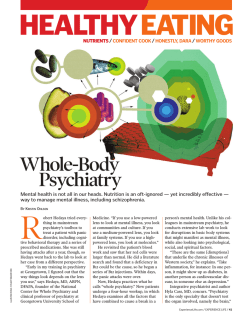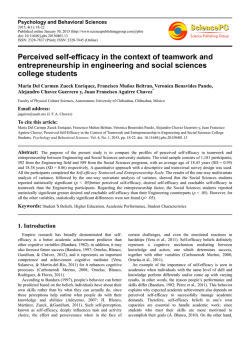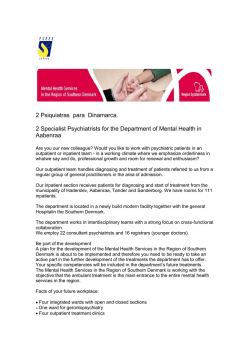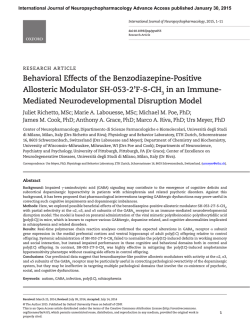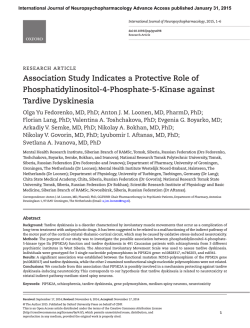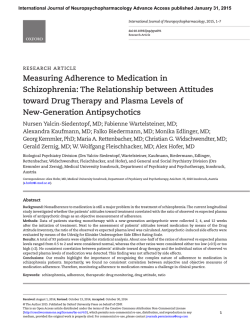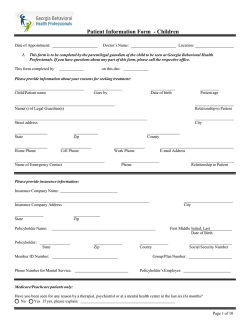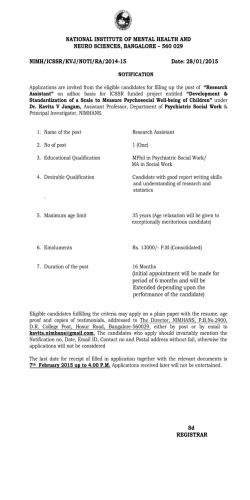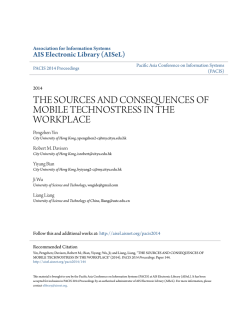
Predictors of Exercise in Individuals with Schizophrenia
Original Contributions Predictors of Exercise in Individuals with Schizophrenia: A Test of the Transtheoretical Model of Behavior Change Bridget Bassilios 1, Fiona Judd 2, Philippa Pattison 3, 4, Angela Nicholas 1, Kristen Moeller-Saxone 1 Abstract Introduction: Mortality in individuals with schizophrenia, including deaths not attributable to accidents and suicide, is at least twice that of the general population. While increasing physical exercise could promote positive mental and physical health outcomes in individuals with schizophrenia, only one other study of the determinants of exercise within this population has been reported. Our study attempts to resolve this void in knowledge by testing the applicability of the transtheoretical model (TTM) of behavior change to predicting exercise behavior in those with schizophrenia. Methods: Forty-nine participants (42 with schizophrenia and 7 with schizoaffective disorder) from three community mental health centers in Melbourne, Australia, completed a series of questionnaires, an interview, physical health measures, and had their medical records examined. These measures were used: TTM exercise stage, TTM mediators of change, health status, health-risk behaviors, use of antipsychotic medications, psychopathology, psychiatric history, and demographic information. Variables found to be significantly correlated with exercise stage were then included in a series of regression analyses to determine their relative predictive power for exercise stage. Results: The results demonstrated that the TTM and its associated measures may be valid for integration into interventions for promoting exercise in individuals with schizophrenia, despite high levels of psychopathology symptoms. Conclusions: Routine clinical practice should promote exercise in people with schizophrenia and the TTM may be of benefit to this end. Strategies that promote exercise when self-perceived poor health is seen as a significant barrier are particularly important, as is the reduction of caffeine consumption and other health-adverse behaviors. Key Words: Schizophrenia, Exercise, Physical Activity, Physical Inactivity, Sedentary Lifestyle, Transtheoretical Model, Stage of Change, Physical Health, Caffeine Introduction Mortality in individuals with schizophrenia is at least twice that of the general population (1, 2). This excess morCentre for Mental Health, Melbourne School of Population Health, University of Melbourne, Victoria, Australia 2 Department of Psychiatry, University of Melbourne, Victoria, Australia 3 Melbourne School of Psychological Sciences, University of Melbourne, Victoria, Australia 4 Office of DVC (Education), University of Sydney 1 Address for correspondence: Bridget Bassilios, DPsych, Centre for Mental Health, Melbourne School of Population Health, University of Melbourne, Melbourne, Victoria 3010, Australia Phone: +61 03 8344 0662; Fax: +61 03 9348 1174; E-mail: [email protected] Submitted: January 19, 2012; Revised: July 3, 2012; Accepted: August 8, 2012 tality is not only attributable to unnatural causes of death, such as accidents and suicide, but also to natural causes of death such as disease (1-3). A systematic review of mortality in schizophrenia—including thirty-seven scholarly articles from twenty-five nations published between January 1, 1980 and January 31, 2006—reported a median standardized mortality ratio for all-natural cause mortality of 2.41 (10%–90% quantile 0.99–4.10) (3). Poor physical health in individuals with schizophrenia relative to the general population has been well documented internationally (4-7). In broad terms, the factors contributing to this excess morbidity include: weight gain, glucose dysregulation, and diabetes side effects of atypical antipsychotic medication (8, 9); a reduced emphasis on physical health by health professionals; cognitive symptoms of schizophrenia itself may Clinical Schizophrenia & Related Psychoses Winter 2015 • 173 Predicting Exercise in People with Schizophrenia Clinical Implications In light of the high prevalence of physical morbidity and mortality documented in people with schizophrenia and the contribution of physical inactivity to this public health problem, routine physical and mental healthcare for these patients should assess this and other health promoting behaviors. The TTM may facilitate tailoring interventions for the promotion of exercise in individuals with schizophrenia, irrespective of severity of psychopathology symptoms. hinder the ability of patients to communicate their physical symptoms; and, lifestyle factors which may be worsened by negative psychotic symptoms. Physical inactivity, through its effects on increased body weight (4, 10, 11) and cardiovascular and other diseases (4, 7, 12-14), represents one such lifestyle factor. A systematic review of three randomized controlled trials concluded that exercise programs are possible in individuals with schizophrenia and that they can have positive effects on mental (e.g., negative symptoms) and physical health (e.g., physical fitness) (15). While it is apparent that regular physical exercise could potentially promote positive mental and physical health outcomes in individuals with schizophrenia (15, 16), to our knowledge only one study of the determinants of exercise within this population has been reported (17). In a sample of 83 people with schizophrenia and 70 people with depression, self-efficacy and intention of physical activity were significant predictors of current physical activity (17). Similarly, a qualitative study of thirty-four patients with serious and persistent mental illness reported several self-efficacy related barriers to exercise, including never learning how to exercise, lack of role models, lack of social and motivational support, and concern about shortness of breath and elevated heart rate (18). Table 1 Description of Behavioral Processes of Exercise Adoption Process Definition Cognitive Consciousness raising Efforts by the individual to seek new information related to exercise activity (e.g., benefits of exercise) Dramatic relief Experiencing and expressing feelings about sedentary lifestyle (e.g., thinking about the negative health consequences of inactivity) Environmental reevaluation Consideration and assessment of how exercise impacts on others in the physical and social environment Social liberation Awareness, availability and acceptance by the individual of societal and social influences on encouraging and promoting exercise Self-reevaluation Emotional and cognitive reappraisal by the individual with respect to exercise activity Behavioral Counterconditioning Helping relationships Trusting, accepting and using the support of caring others to enhance and assist with the individual’s exercise activity Reinforcement management Changing the contingencies that control or maintain sedentary behavior (e.g., use of positive reinforcement and goal setting to increase exercise) 174 • Use of exercise to cope with unpleasant emotions (e.g., stress, fatigue) Stimulus control Control of situations and other causes which trigger inactivity Self-liberation The individual’s choice and commitment to maintain exercise Clinical Schizophrenia & Related Psychoses Winter 2015 Bridget Bassilios et al. Self-efficacy is one component of the transtheoretical model (TTM), one of the most widely used theories to explain behavior change (19). The TTM identifies five stages of exercise adoption: precontemplation (no intention to exercise in the next six months); contemplation (thinking about exercising within the next six months); preparation (intention to exercise within the next month and previous attempts to exercise in the previous year); action (successfully exercising for a period between one day and six months); and, maintenance (successfully exercising for more than six months). Previous iterations of the TTM did not include the preparation stage (20). The model is cyclical rather than linear, with relapse accepted as part of the change cycle. The TTM postulates that the constructs of self-efficacy, decisional balance of perceived benefits and costs, and cognitive and behavioral processes (strategies and techniques) mediate exercise behavior. In terms of the latter, ten processes of change have been identified and are classified as either cognitive (e.g., seeking information about the benefits of exercise or considering the negative consequences of physical inactivity) or behavioral (e.g., use of exercise to cope with negative emotions or positive reinforcement to increase exercise) (21). These processes are outlined in Table 1. Meta-analytic findings suggest that the TTM is an empirically supported framework for understanding exercise behavior in the general population (22). Generally, a higher level of exercise self-efficacy (23-25), increased use of the processes of change (22, 26), greater perception of the benefits, and lower perception of the costs of exercise (21) are predictive of a higher exercise stage and, therefore, more regular exercise. Two previous studies have applied the stages component of the TTM to the assessment of physical activity in populations with psychotic disorders (27, 28). One of these studies reported that stages of change for physical activity were associated with self-reported vigorous and moderate—but not mild—physical activity and 54% were ready to become physically active (27). The other study established concurrent validity between stages of change and another self-report physical activity scale (28). The TTM in its entirety (i.e., stages and mediators of change) has also been successfully used in a psychiatric sample to increase understanding of other health-risk behaviors, such as alcoholism (29). This is the first study to test the TTM in its entirety to examine its applicability to physical activity in individuals with schizophrenia. In addition, a number of other predictors of low physical activity in the general population have been identified in the literature. These include health-risk behaviors such as smoking (4, 7), illicit drug use, alcohol consumption (4) and excessive caffeine intake (30-32); demographic variables such as level of education (33), age (34), gender (35), and ethnicity (33); socioeconomic status (36); and, poor physical health (30) as indicated by body mass index, blood pressure and self-rated health status. Furthermore, a number of illness-related factors, not yet tested, is also likely to affect exercise behavior in individuals with schizophrenia. Level of functioning is moderated by positive symptoms, negative symptoms, affect and antipsychotic medication side effects (37), and is likely to influence motivation and ability to engage in exercise. This study aims to add to the existing evidence base by analyzing the power of the TTM in its entirety to predict level of exercise in a sample of individuals with schizophrenia. The role of TTM mediators (processes, self-efficacy and decisional balance) in determining naturally occurring exercise stage in this group is explored. Knowledge of those factors predicting exercise behavior in this group can be used to inform routine clinical practice and targeted interventions that promote physical activity. The role of clinical symptomatology, including positive and negative psychotic symptoms and depression, as well as physical health, in the prediction of exercise and their influence on the TTM predictors, is also investigated. Furthermore, the potential relationship between exercise stage and several additional factors, including demographic characteristics, other healthrisk behaviors, side effects of medication and other psychiatric illness-related characteristics, is explored. Finally, there is a concern that the effect of exercise self-efficacy on level of exercise will be confounded by general self-efficacy. General self-efficacy is likely to be low among those with schizophrenia as a result of the pervasive effects of negative symptoms (38, 39). Therefore, an examination of the relationship between these two variables, and their respective relationships to exercise stage, is also examined. Methods Design This is a correlational study with a cross-sectional design. The dependent variable is current level of exercise activity (exercise stage). The independent variables are the mediators of exercise stage (exercise self-efficacy, evaluation of costs and benefits of exercising, and the utilization of cognitive and behavioral processes related to exercise behavior), clinical symptom severity (positive and negative psychotic symptoms and depression), and physical health. Multiple regression analyses addressed the relationship of TTM mediators of exercise with exercise stage, and the additional contribution of various predictor variables. Clinical Schizophrenia & Related Psychoses Winter 2015 • 175 Predicting Exercise in People with Schizophrenia Participants A convenience sample comprised of individuals diagnosed with a psychotic disorder, aged 18 years or older and attending three community mental health services in Melbourne, Australia, was invited to take part in the study. Exclusion criteria were an inability to provide informed consent or to speak English, or being deemed too unwell by the treating clinicians. Individ- uals were invited to participate by their treating clinicians or responded to an advertisement placed in clinic waiting areas. Measures All measures used in the current study are outlined in Table 2, with elaboration of only those measures relevant to the multivariate analyses. Table 2 Measures Used in the Current Study Variables Scale/Measure Source Age/Marital status/Country of birth/Living arrangements National Health Survey Australian Bureau of Statistics, 1996 (47) Exercise Stage Exercise Stages of Change Measure University of Rhode Island, Cancer Prevention Research Centre website (2001) (58) Exercise Processes of Change Exercise Processes of Change Scale University of Rhode Island, Cancer Prevention Research Centre website (2001) (58) Exercise Self-Efficacy Exercise Self-Efficacy Scale University of Rhode Island, Cancer Prevention Research Centre website (2001) (58) Exercise Decisional Balance Exercise Decisional Balance Measure University of Rhode Island, Cancer Prevention Research Centre website (2001) (58) Current exercise behavior; past exercise behavior; intention to exercise Exercise Behavior Interview developed using six items from the Risk Factor Prevalence Study National Heart Foundation of Australia and Australian Institute of Health, 1991 (44) Positive and negative symptoms/ general psychopathology The Positive and Negative Syndrome Scale (PANSS) Kay et al., 1989 (45) Depression Centre for Epidemiological Studies Depression Scale (CES-D) Radloff, 1977 (46) Self-rated health/health compared to one year ago National Health Survey Australian Bureau of Statistics, 1996 (47) Blood pressure — Body mass index Weight (kg)/height2 (meters) General Self-Efficacy (GSE) Subscale of the Self-Efficacy Scale Sherer and Maddux, 1982 (39) Tobacco use Standard Tobacco Use Questions Centre for Behavioral Research in Cancer, 1998 (59) Alcohol consumption Australian National Drug Strategy Household Survey Australian Bureau of Statistics, 1996 (47) Caffeine consumption Two questions each for coffee, tea and cola consumption to obtain a total daily caffeine consumption score Cardiovascular Behavioral Health Unit, La Trobe University (60) Illicit drug use Nine items derived from the National Drug Strategy Commonwealth Dept. of Health and Family Services, 1996 (61) Psychiatric diagnosis/illness duration/time since last psychiatric admission/ medication type Respondents asked directly and confirmed by case managers and medical files where possible. Medications: typical/atypical antipsychotics and other medications Questions constructed by the first author 176 • Clinical Schizophrenia & Related Psychoses Winter 2015 Bridget Bassilios et al. Exercise Stage The exercise stage measure assesses exercise stage by asking respondents whether they exercise according to a prescribed definition: “any planned physical activity performed to increase physical fitness and performed 3–5 times per week for 20–60 minutes and performed at a level that increases breathing rate and causes sweat to break” (40). Respondents are provided with five responses (each corresponding to an exercise stage) and are placed into the stage representing the item endorsed most strongly, using a 5-point Likert scale, from 1=“strongly disagree” to 5=“strongly agree.” The scale has a reliability of .78 over a two-week period (21, 40) and is based on a modification of a similar measure developed for assessing stage of smoking cessation (21). Exercise Processes This is a 30-item measure designed to determine the processes used by people, over the past month, in relation to exercise behavior (41). Processes used are classified into 10 subscales, half of which are cognitive/experiential and the other half of which are behavioral. The items are rated on a 5-point Likert scale, ranging from 1=“never” to 5=“repeatedly.” The overall score for the measure is obtained by summing the items, with higher scores indicating greater utilization of exercise processes. In addition to possessing strong face and content validity, the internal consistency of the items has been demonstrated, with alpha correlations of the ten subscales ranging from .67 to .86. Based on evidence that the majority of individuals with a mental illness are unemployed (42), one of the counterconditioning items (“Instead of taking a nap after work, I exercise”) was excluded in the present study. Exercise Self-Efficacy Scale This is an 18-item scale designed to determine individual confidence to exercise in the face of certain obstacles (43). The obstacles to exercise are classified into six factors: negative affect, excuse making, must exercise alone, inconvenience, resistance from others, and bad weather. The validity and reliability of the scale are sound, with internal consistencies of the six factors ranging from .77 to .87 (43). Items are rated on a 5-point Likert scale, ranging from 1=“not at all confident” to 5=“completely confident.” The overall score is obtained by summing the individual responses, with higher scores indicating greater exercise self-efficacy. Minor changes in wording of two of the bad weather items were implemented to render them applicable to an Australian population (i.e., confidence to exercise when “it’s raining or snowing” and “the roads or sidewalks are snowy” were changed to “it’s raining” and “the roads or footpaths are wet”, respectively). In addition, “I am confident to exercise when” was repeated at the commencement of each item to assist participants to maintain the focus of the questionnaire. Exercise Decisional Balance (Pros/Cons) The exercise decisional balance measure employed for the current study consists of ten benefits (pros) of exercising items and six costs (cons) of exercising items (40). The internal consistency of the benefit and cost items are .95 and .79, respectively. Respondents are required to indicate, on a 5-point Likert scale ranging from 1=“not at all important” to 5=“extremely important,” how important each item is in relation to their decision to exercise. A decisional balance score is obtained by subtracting the total of the costs from the total of the benefits and is significantly associated with exercise stage (40). However, to enable comparison with past research, the pros and cons scores were used as separate variables. Exercise Behavior Interview This interview was constructed for the purpose of the present study to assess current and past exercise behavior, as well as intention to exercise. The rationale for including this interview was to use open-ended questions to confirm the validity of the stage endorsed by participants in the exercise stage measure. The interview included six items from the Australian Risk Factor Prevalence Study (44), which assess the intensity and frequency of physical activity, including physical activity related to housework and employment, over the previous two weeks. Similar questions were incorporated to assess past exercise behavior as well as future intentions regarding exercise. Psychopathology The Positive and Negative Syndrome Scale (PANSS) was used to assess the presence and severity of seven positive, seven negative, and sixteen general psychopathology symptoms over the previous week (45). The Centre for Epidemiological Studies Depression Scale (CES-D) was used to assess depressive symptoms; it is the most widely used self-report measure of depression in the community and is designed to assess the frequency and severity of depressive symptoms over the previous week (46). Physical Health Respondents’ perception of their own physical health was assessed using two items from the Australian National Health Survey (47). The first item requests respondents to rate their present health on a five-point scale from 1=“excel- Clinical Schizophrenia & Related Psychoses Winter 2015 • 177 Predicting Exercise in People with Schizophrenia lent” to 5=“poor.” The second item requires respondents to compare their present health to one year ago, from 1=“much better” to 5=“much worse.” Blood pressure and body mass index (BMI) were also assessed as objective indicators of physical health status. BMI was calculated as weight (kg)/ height2 (meters). In accordance with Australian National Health and Medical Research Council (NHMRC) guidelines at the time of this study, a BMI of under 18.5 was underweight, 18.5 to less than 25 was normal, 25 to less than 30 was overweight and 30 or above was obese (30). General Self-Efficacy The general self-efficacy subscale, which does not refer to any specific behavioral domain and accounts for 26.5% of variance of the Self-Efficacy Scale (39), was considered to be pertinent in the current study for the purpose of determining the specificity of the exercise self-efficacy measure. Procedures Ethics approval was obtained from the North Western Mental Health Behavioral and Psychiatric Research and Ethics Committee, and the Austin and Repatriation Medical Centre Research and Ethics Committee. Informed consent of all participants was obtained. All data were collected during an interview with each participant conducted by the first author, who had received formal training in the use of the PANSS. Physical health measures (blood pressure, height and weight) were assessed by a nurse on duty at the community mental health center. Participants were provided with a single visit free pass for a nearby fitness center. Statistical Analyses Statistical analyses were carried out using Statistics Package for the Social Sciences 11.0 (SPSS 11.0). Comparisons between groups were conducted using either independent samples t-tests or chi-square analyses. Internal consistencies for quantitative measures were calculated using Cronbach’s alpha coefficients. Exercise stage was treated as a continuous variable, as it has been in previous research (48) because stage of change has an underlying continuum of time. To determine those independent variables to be included in subsequent regression analyses, the relationships between all independent variables and exercise stage were carried out using Pearson product-moment correlations, independent samples t-tests or chi-square analyses. Those variables that did not demonstrate a significant relationship with exercise stage were excluded from further analyses. Standard multiple and hierarchical regression analyses were used to analyze the relative strength of all independent variables in the prediction of exercise stage. All four TTM 178 • Clinical Schizophrenia & Related Psychoses Winter 2015 mediators were entered in the first—and other relevant predictors in the second—step of the regression analyses. Results Sample Characteristics Eighty-six clients were invited, and fifty-one agreed to participate in the study. Two participants did not complete the study, resulting in a sample size of forty-nine. Forty-two participants (85.7%) had been diagnosed with schizophrenia and seven (14.3%) with schizoaffective disorder. Demographics, Antipsychotic Medication, and Illness Duration The average age of participants was 39 years and the majority were males (71%) of Australian origin (82%) who had never been married (70%). The average illness duration was 14 years, with 61% on atypical, 20% on typical and 16% on a combination of antipsychotic medication. No significant differences were found between participants and nonparticipants on demographics, antipsychotic medication and illness duration (49). Comparisons of participants from the “Body and Mind Project” (42), which examined the risk factors for physical health in a psychiatric sample of 234 patients treated in community mental health clinics (79% with schizophrenia), with current study participants indicated that the two samples were largely comparable (49). Exercise Stage A high correlation between “rated” exercise stage, as determined by the exercise stage questionnaire, and “actual” exercise stage, as determined by the exercise behavior interview, (r=.954, p=.000) confirmed the stage deduced by the exercise stage of change measure and indicated that the measure was applicable to the psychiatric sample involved. TTM Mediators of Exercise and Psychopathology Mean scores and standard deviations for the TTM mediators of exercise are shown in Table 3. Adequate to high internal consistencies were found for the exercise processes, exercise self-efficacy and the evaluation of exercise pros and cons scales in the current sample (see Table 3). Positive, negative and general psychopathology scores were in the “moderate” range (see Table 3). The average score for depression was just over the cut-off of 16 for depression, with 51% of participants scoring under 16, 12% scoring 16 to 19, and 37% scoring 20 or more. Internal consistency for measures of psychopathology (see Table 3) ranged from moderate for positive symptoms and general psychopathology to high for negative symptoms and depression. Bridget Bassilios et al. Table 3 Mean Scores, Standard Deviations and Scale Reliability for Psycho pathology Symptoms and TTM Exercise Mediators (N=49) Mean SD Reliability Coefficient (Cronbach’s α) Positive symptoms 16.53 4.99 .62 Negative symptoms 19.27 6.90 .82 General psychopathology 38.67 8.66 .71 Depression 17.86 12.05 .91 Exercise processes 80.51 18.46 .91 Exercise self-efficacy 44.06 16.09 .94 Pros of exercise 39.47 8.91 .93 Cons of exercise 15.56 5.44 .77 Independent Variable Psychopathology TTM exercise mediators Physical Health Just over one-fifth of participants recorded a systolic blood pressure indicative of systolic hypertension (above 140 mmHg) and 28.6% were above the cut-off for diastolic hypertension (90 mmHg). The majority of the sample was either overweight or obese (61%), and only 22.5% self-rated their health as being “excellent” or “very good.” However, almost half (48.9%) of participants rated their health compared to one year ago as “much better” or “somewhat better.” Health-Risk Behaviors The majority (59%) of participants reported smoking tobacco daily. The mean number of cigarettes per day was 24 (SD=11, range=4–50). Approximately 43% of the sample reported that they last had an alcoholic drink within the previous week and 6.1% were drinking at a “risky to high risk” level. Just over one-third of participants in the present study reported that they had used illicit drugs. Marijuana was most frequently used. Overall, the mean caffeine consumption from coffee, tea and cola drinks was estimated to be 503 mg (SD=388 mg, range=0–1,750 mg). health measures, physical health measures, psychiatric illness-related characteristics, health-risk behaviors and side effects of antipsychotic medication (reported elsewhere) showed that only self-rated health (r [47]=-.41, p=.000) and daily caffeine consumption (mg; Pearson’s correlation coefficient of r=-.26, p=.04) were significantly related to exercise stage (49), and, therefore, included in regression analyses. Relationship between Exercise SelfEfficacy, General Self-Efficacy and Exercise Stage Analyses conducted to determine whether exercise selfefficacy (ESE) was a valid measurement within the target population, or whether it was merely a reflection of low general self-efficacy (GSE) in the context of negative symptoms, demonstrated that although the two variables are related (r=.43, p=.001), GSE does not constrain ESE (49). While fluctuations in ESE were observed, GSE was relatively stable across exercise stages (49). Simple correlations demonstrated that while ESE was significantly associated with exercise stage (r=.25, p=.04), GSE was not (r=.16, p=.28). Because there was a positive relationship between exercise self-efficacy and general selfefficacy, exercise self-efficacy and general self-efficacy were both included in the regression analyses. Relationships between Exercise Stage and Independent Variables Table 4 shows the relationship between exercise stage and the predictors (TTM mediating constructs, psychopathology symptoms, self-rated health, caffeine consumption and general self-efficacy). There was a significant positive Table 4 Predictor Variables Preliminary Analyses Relationships Between Exercise Stage, Demographics, Health, Psychopathology, Health-Risk Behaviors and Medication Side Effects Preliminary examination of the relationships between exercise stage and demographic characteristics, self-rated Correlation between Exercise Stage (Outcome) and Predictor Variables Exercise Stage Exercise processes .38† Exercise self-efficacy .25* Pros of exercise .33† Cons of exercise -.10 Positive symptoms -.16 Negative symptoms -.24* Depression -.25 Self-rated health -.41† Caffeine consumption -.26* General self-efficacy .16 p<.05, †p<.01. * Clinical Schizophrenia & Related Psychoses Winter 2015 • 179 Predicting Exercise in People with Schizophrenia association between exercise stage and each of the exercise processes, exercise self-efficacy and pros of exercise. Exercise stage was inversely related to negative symptoms, poor selfrated health and caffeine consumption. Table 5 Regression Analyses Testing the TTM of Exercise Behavior The combination of all four independent TTM mediators of exercise (exercise processes, exercise self-efficacy, exercise pros and exercise cons) in a multiple regression accounted for a significant percentage of variance (20%) in stage of exercise, r=.45, F(4,44)=2.77, p=.039. However, there was no significant independent contribution of any of the predictors (see Table 5). Prediction of Exercise Stage Using TTM Exercise Mediators and Psychopathology Simple Correlations between Exercise Stage and Predictor Variable and Results of Standard Multiple Regressions Testing the Role of TTM Exercise Mediators, Psychopathology, Self-Rated Health, Caffeine Consumption and General Self-Efficacy in the Prediction of Exercise Stage Predictor Prediction of Exercise Stage Using TTM Exercise Mediators and GSE Addition of general self-efficacy to the equation containing the TTM mediators of exercise did not account for a significant increment in the percentage of variance (20%) in exercise stage: r2=.20, Finc(1,43)=0.75, p=.39 (see Table 5). 180 • Clinical Schizophrenia & Related Psychoses Winter 2015 .45 .20* .15 Exercise processes Exercise self-efficacy .17 Pros of exercise .28 Cons of exercise -.10 Prediction of Exercise Stage Using TTM Exercise Mediators and Self-Rated Health Addition of caffeine consumption to the equation containing the TTM mediators of exercise accounted for a significant increment in the percentage of variance (28%) in exercise stage: r2=.28, Finc(1,42)=5.22, p=.03. Caffeine consumption was the only variable to make a significant independent contribution to the prediction of exercise stage (see Table 5). b TTM and psychopathology Testing the Contribution of Caffeine Consumption to the Prediction of Exercise Stage R2 TTM Addition of the psychopathology variables to the equation containing the TTM mediators of exercise in hierarchical multiple regression analyses did not reliably improve the prediction of exercise stage: r2=.27, Finc(3,41)=1.19, p=.33 (see Table 5). Addition of self-rated health to the equation containing the TTM mediators of exercise accounted for a significant increment in the percentage of variance (31%) explained for exercise stage: r2=.31, Finc(1,43)=6.59, p=.01. Furthermore, self-rated health was the only significant independent contributor to the prediction of exercise stage (see Table 5). R Exercise processes Exercise self-efficacy .52 .26 .13 Pros of exercise .26 Cons of exercise -.04 Positive symptoms -.14 Negative symptoms -.16 .14 Depression -.14 TTM and self-rated health Exercise processes Exercise self-efficacy Pros of exercise .25 Cons of exercise -.13 Self-rated health -.34* .55 .31* .12 .13 TTM and caffeine consumption Exercise processes Exercise self-efficacy .14 Pros of exercise .27 Cons of exercise -.13 Caffeine consumption -.30* .53 .28 .19 TTM and general self-efficacy Exercise processes Exercise self-efficacy Pros of exercise .28 Cons of exercise -.10 General self-efficacy .01 p<.05 * .45 .22 .15 .17 Bridget Bassilios et al. Discussion The current study investigated the potential applicability of the TTM to the prediction of exercise behavior in individuals with schizophrenia and attempted to elucidate the strength of other factors that may be relevant to the prediction of exercise within this population: psychopathology, physical health, demographic characteristics, health-risk behaviors, side effects of medication and other psychiatric illness-related characteristics. Understanding the factors that explain naturally occurring physical activity in this group can inform targeted interventions to improve physical health. Consistent with previous findings, a sedentary lifestyle was far more common among this sample with schizophrenia than in the general population (4, 7, 50, 51). The strong association between exercise stage as determined by the exercise stage measure and by the exercise behavior interview suggests that the exercise stage measure is valid and applicable to individuals with schizophrenia. This finding supports the sole study testing concurrent validity between the stage of change measure and another self-report physical activity scale (28). Not previously tested, the TTM mediators of exercise explained a significant proportion of variance in exercise stage, supporting the applicability of the TTM to exercise behavior in schizophrenia. No TTM mediator alone contributed significantly to the prediction of exercise stage, suggesting that effects are correlated but predictive of exercise stage. These findings are also broadly consistent with previous studies of the general population (21, 22). Therefore, interventions for individuals with schizophrenia that can create higher exercise self-efficacy, promote greater use of the processes of exercise change, increase the salience of exercise benefits and reduce salience of the costs may promote exercise participation. Increasing exercise self-efficacy may be particularly important for the transition between precontemplation and contemplation than for the initiation and maintenance of exercise in individuals with schizophrenia (49). Decreasing the perceived costs of exercise may be more important than increasing the benefits for the preparation to action and precontemplation to contemplation stage transitions in individuals with schizophrenia (49). Use of the behavioral processes (e.g., counterconditioning, helping relationships, reinforcement, stimulus control and self-liberation) may be particularly necessary in the stage transition between contemplation and preparation (49). Accordingly, stage-targeted or matched interventions (52) may be applicable to individuals with schizophrenia. However, a review of the effectiveness of interventions based on the TTM has suggested that these interventions are more effective in promoting activity adoption than adherence (53). General self-efficacy did not add to the prediction of exercise stage made by the TTM mediators and, while exercise self-efficacy was significantly related to exercise stage, general self-efficacy was not, suggesting that enhanced exercise self-efficacy alone can potentially contribute to more frequent exercise, without an increase in general self-efficacy. However, it is noted that exercise self-efficacy in schizophrenia spectrum disorders is thought to fluctuate over time and, therefore, its maintenance requires active assistance from professionals (54). Negative psychotic symptoms and depression were significantly negatively associated with exercise stage, and this is not surprising given their impact on energy, motivation, concentration, interest and ability to enjoy activities. However, the addition of psychopathology symptoms did not add to the prediction of exercise stage made by the TTM mediators. Therefore, exercise interventions based on the TTM model may increase the likelihood of individuals with schizophrenia adopting and adhering to exercise despite a pessimistic clinical symptom profile. Self-rated health was the only individual variable that accounted for a significant proportion of variance in—and made a significant independent contribution to—the prediction of exercise stage when added to the TTM mediating constructs. Furthermore, individuals with schizophrenia, generally possessing a self-concept of fair or good health, are less likely to form a strong intention to engage in exercise than individuals having a self-concept of very good or excellent health. The effect is circular, with inactivity contributing to poor health and poor health reducing the likelihood of participating in exercise activity. This demonstrates the necessity for implementation of strategies that promote exercise in spite of poor self-rated physical health, which may be seen as a significant barrier to change. The study sample was less than half as likely as the general Australian population (30) to rate their health as “excellent” or “very good” (22.5% vs. 54.5%), over twice as likely to suffer hypertension (29% vs. 13%) (55), and obesity was triple the prevalence (41% vs. 14%) (55). These results support previous studies indicating that the physical health of individuals with schizophrenia is worse than that of the general population (42, 51) and counter the possibility that their self-rated health is influenced by poor insight. Alternatively, given that previous research has indicated that schizophrenia patients with good insight into their illness report poorer physical health (56), it is possible that our sample had good insight accounting for their poorer self-rated health. It has been suggested that health behaviors, such as exercise and fruit and vegetable intake, may be correlated within the general population (32). This is also likely to be the case in individuals with schizophrenia and may explain Clinical Schizophrenia & Related Psychoses Winter 2015 • 181 Predicting Exercise in People with Schizophrenia why caffeine consumption offered a unique contribution to the prediction of exercise stage beyond that made by the TTM mediators. It may, therefore, be beneficial to simultaneously encourage the reduction of daily caffeine intake (and other health-adverse behaviors) when attempting to promote exercise activity in individuals with schizophrenia. Previous research has noted that regular exercisers are 30% more likely to reduce caffeine consumption (46). Additionally, high caffeine consumption by individuals with schizophrenia may contribute to poorer self-concept of health, thereby reducing intention to, and participation in, exercise. This counters the view that psychiatric patients are generally not motivated for exercise compared to the normal population despite the experience of more (illness-related) barriers. The relationship between health-risk behaviors, such as physical inactivity and caffeine consumption, in this psychiatric sample may be plausibly explained by the likely effects of negative psychotic symptoms, such as apathy, avolition and anhedonia, all of which are likely to result in amotivation. However, intrinsic motivation (or experiencing physical activity as pleasant and enjoyable) as well as exercise self-schema (or viewing oneself as physically active) in a psychiatric population (with unrecorded diagnoses) and exposure to physical activity as part of their treatment was found to be positively and significantly correlated with physical activity level (57). This counters the view that psychiatric patients are generally not motivated for exercise compared to the normal population despite the experience of more (illness-related) barriers (57). The failure to find an effect of the costs of exercise on exercise stage may be in part attributable to the nature of the items assessing this construct. Some of the costs measured such as “being too tired to do daily work after exercising” may not be applicable to individuals with schizophrenia because of low rates of employment. Substitution of more relevant costs in the measure may lead to different results. The findings of this study should be considered in the context of its methodological limitations. The small sample size used in the current study, particularly those in the later exercise stages, limited the power of the statistical analyses performed and may have inflated the effect sizes needed to obtain significant results. The small sample size may also limit the generalizability of results; however, similarities in the profile of our sample and another local study (4, 42) indicate that our sample was largely representative of the population of interest. Also, the cross-sectional design of the study 182 • Clinical Schizophrenia & Related Psychoses Winter 2015 does not allow for determining cause-and-effect relationships between the predictors and exercise, and longitudinal and experimental studies of stage-matched and mismatched interventions are needed to provide stronger evidence of the nature and direction of causal paths (17). The current study demonstrates that the TTM and its associated mediators may be valid for integration into interventions for promoting exercise behavior in individuals with schizophrenia even in the face of a high level of psychopathology symptoms. Strategies that promote exercise when self-perceived poor health is seen as a significant barrier will be important as will the reduction of caffeine consumption and other health-adverse behaviors. Future research in this area should reconsider the validity of some “cons” of exercise used in the TTM mediator measures to ensure their applicability to this sample. Acknowledgments The authors thank the staff from Inner West Area Mental Health Service, North East Area Community Mental Health Service and North West Area Mental Health Service without whom participant recruitment would not have been possible, and all the participants who kindly provided the data necessary for our analysis. The authors also thank Professor Jane Pirkis for invaluable encouragement and support in the preparation of the manuscript. References 1. Brown S, Inskip H, Barraclough B. Causes of the excess mortality of schizophrenia. Br J Psychiatry 2000;177:212-217. 2. Harris EC, Barraclough B. Excess mortality of mental disorder. Br J Psychiatry 1998;173:11-53. 3. Saha S, Chant D, McGrath J. A systematic review of mortality in schizophrenia: is the differential mortality gap worsening over time? Arch Gen Psychiatry 2007;64(10):1123-1131. 4. Davidson S, Judd F, Jolley D, Hocking B, Thompson S, Hyland B. Cardiovascular risk factors for people with mental illness. Aust N Z J Psychiatry 2001;35(2):196-202. 5. Dickerson FB, Brown CH, Daumit GL, LiJuan F, Goldberg RW, Wohlheiter K, et al. Health stauts of individuals with serious mental illness. Schizophr Bull 2006;32(3):584-589. 6. Vieweg V, Pandurangi A, Levenson J, Silverman J. Medical disorders in the schizophrenic patient. Int J Psychiat Med 1995;25(2):137-172. 7. Osborn DPJ, Nazareth I, King MB. Physical activity, dietary habits and coronary heart disease risk factor knowledge amongst people with severe mental illness: a cross sectional comparative study in primary care. Social Psych Psych Epid 2007;42(10):787-793. 8. Ananth J, Venkatesh R, Burgoyne K, Gadasalli R, Binford R, Gunatilake S. Atypical antipsychotic induced weight gain: pathophysiology and management. Ann Clin Psychiatry 2004;16:75-85. 9. Jin H, Meyer JM, Jeste DV. Atypical antipsychotics and glucose dysregulation: a systematic review. Schizophr Res 2004;71:195-212. 10. Gopalaswamy AK, Morgan R. Too many chronic mentally disabled patients are too fat. Acta Psychiatr Scand 1985;72:254-258. 11. Wallace B, Tennant C. Nutrition and obesity in the chronic mentally ill. Aust N Z J Psychiatry 1998;32:82-85. 12. Bauman A, Owen N. Physical activity of adult Australians: epidemio- Bridget Bassilios et al. logical evidence and potential strategies for health gain. J Sci Med Sport 1999;2(1):30-41. pation: does availability and accessibility differ by neighborhood socioeconomic status? Ann Behav Med 2003;25(2):100-104. 13. Crespo CJ. Exercise and the prevention of chronic disabling illness. In: Frontera WR, Dawson DM, Slovik DM, editors. Exercise in rehabilitation medicine. Champaign (IL): Human Kinetics; 1999. p. 151-172. 37. Jacobs P, Chrichton E, Visotina M. Practical approaches to mental health care. Melbourne, Australia: The Macmillan Company of Australia; 1989. 14. Pate RR, Pratt M, Blair SN, Haskell WL, Macera CA, Bouchard C, et al. Physical activity and public health: a recommendation from the Centers for Disease Control and Prevention and the American College of Sports Medicine. JAMA 1995;273(5):402-407. 15. Gorczynski P, Faulkner G. Exercise therapy for schizophrenia. Cochrane Database of Systematic Reviews 2010; Issue 5: Art. No.: CD004412. doi: 10.1002/14651858.CD004412.pub2. 16. Faulkner G, Biddle S. Exercise as an adjunct treatment for schizophrenia: a review of the literature. J Ment Health 1999;8(5):441-457. 17. Leas L, McCabe M. Health behaviors among individuals with schizoprhenia and depression. J Health Psychol 2007;12(4):563-579. 18. McDevitt J, Snyder M, Miller A, Wilbur J. Perceptions of barriers and benefits to physical activity among outpatients in psychiatric rehabilitation. J Nurs Scholarship 2006;38(1):5-55. 19. Di Clemente CC, Prochaska JO. Self-change and therapy change of smoking behavior: a comparison of processes of cessation and maintenance. Addictive Behaviors 1982;7:133-142. 20. Velcier WF, Rossi JS, Prochaska JO, DiClemente CC. The criterion measurement model for health behvior change. Addict Behav 1996;21(5):555-584. 21. Prochaska JO, Marcus BH. The transtheoretical model: applications to exercise. In: Dishman RK, editor. Advances in exercise adherence. Champaign (IL): Human Kinetics; 1994. p. 161-180. 22. Marshall SJ, Biddle SJH. The transtheoretical model of behavior change: a meta-analysis of applications to physical activity and exercise. Ann Behav Med 2001;23(4):229-246. 23. Di Clemente CC, Prochaska JO, Gilbertini M. Self-efficacy and the stages of self-change of smoking. Cognitive Ther Res 1985;9(2):181-200. 24. Marcus BH, Selby VC, Niaura RS, Rossi JS. Self-efficacy and the stages of exercise behavior change. Res Q Exercise Sport 1992;63(1):60-66. 25. Nigg CR, Courneya KS. Transtheoretical model: examining adolescent exercise behavior. J Adolescent Health 1998;22:214-224. 26. Marcus BH, Simkin LR, Rossi JS, Pinto BM. Longitudinal shifts in employees’ stages and processes of exercise behavior change. Am J Health Promot 1996;10(3):195-200. 27. Archie SM, Goldberg JO, Akhtar-Danesh N, Landeen J, McColl L, McNiven J. Psychotic disorders, eating habits, and physical activity: who is ready for lifestyle changes? Psychiatr Serv 2007;58(2):233-239. 28. Lindamer LA, McKibbin C, Norman GJ, Jordan L, Harrison K, Abeyesinhe S, et al. Assessment of physical activity in middle-aged and older adults with schizophrenia. Schizophr Res 2008;104(1-3):294-301. 29. Velasquez MM, Carbonari JP, Di Clemente CC. Psychiatric severity and behavior change in alcoholism: the relation of the transtheoretical model variables to psychiatric distress in dually diagnosed patients. Add Behav 1999;24(4):481-496. 30. Australian Bureau of Statistics (ABS). National health survey: summary of results, Australia (No. 4364.0). Canberra: ABS; 2001. 31. Johnson NA, Boyle CA, Heller RF. Leisure-time physical activity and other health behaviors: are they related? Aust J Public Health 1995;19(1):69-75. 32. Sarkin JA, Nigg CR, Norman GJ, Rossi JS. Is exercise stage of change related to other health behaviors? [Abstract]. Med Sci Sport Exer 1999;31(Suppl 5):S273. 33. Dowda M, Ainsworth BE, Addy CL, Saunders R, Riner W. Correlates of physical activity among U.S. young adults, 18 to 30 years of age from NHANES III. Ann Behav Med 2003;26(1):15-23. 34. Booth ML, Macaskill P, Owen N, Oldenburg B, Marcus BH, Bauman A. Population prevalence and correlates of stages of change in physical activity. Health Educ Quart 1993;20(3):431-440. 35. O’Hea EL, Wood KB, Brantely PJ. The transtheoretical model: gender differences across three health behaviors. Am J Health Behav 2003;27(6):645-656. 36. Estabrooks PA, Lee RE, Gyurcsik NC. Resources for physical activity partici- 38. McCay EA, Seeman MV. A scale to measure the impact of schizophrenic illness on an individual’s self-concept. Arch Psychiat Nurs 1998;12(1):41-49. 39. Sherer M, Maddux JE. The self-efficacy scale: construction and validation. Psychol Rep 1982;51:663-671. 40. Marcus BH, Rakowski W, Rossi JS. Assessing motivational readiness and decision making for exercise. Health Psychol 1992;11(4):257-261. 41. Nigg CR, Rossi SJ, Norman GJ, Benisovich SV. Processes of exercise behavior change: redeveloping the scale. San Diego (CA): Society of Behavioral Medicine; 1998. 42. Davidson S, Judd F, Jolley D, Hocking B, Thompson S. The general health status of people with mental illness. Australas Psychiatry 2000;8(1):31-35. 43. Benisovich SV, Rossi JS, Norman GJ, Nigg CR. A multidimensional approach to exercise self-efficacy: relationship with exercise behavior and attitudes towards exercise. Annual Meeting of the England Psychological Association; Boston, MA; 1998. 44. National Heart Foundation of Australia (NHF), Australian Institute of Health (AIH). Risk factor prevalence study: Survey No. 3. Cities Analysis 1989. Canberra: NHF/AIH; 1991. 45. Kay SR, Opler LA, Lindenmayer JP. The positive and negative syndrome scale (PANSS): rationale and standardisation. Br J Psychiatry 1989;155(Suppl 7):59-65. 46. Radloff LS. The CES-D scale: a self-report depression scale for research in the general population. Appl Psychol Meas 1977;1:385-401. 47. Australian Bureau of Statistics (ABS). 1995 National health survey: user’s guide, Australia (No. 4263.0). Canberra: ABS; 1996. 48. Cardinal BJ. Predicting exercise behavior using components of the transtheoretical model of behavior change. J Sport Behav 1997;20(3):272-283. 49. Bassilios B. Physical exercise activity in individuals with schizophrenia. Melbourne, Australia: The University of Melbourne; 2005 [cited 2012 January 18]. Available from http://repository.unimelb.edu.au/10187/11197. 50. Brown S, Birtwistle J, Roe L, Thompson C. The unhealthy lifestyle of people with schizophrenia. Psychol Med 1999;29:697-701. 51. Brown S, Smith E. Can a brief health promotion intervention delivered by mental health key workers improve clients’ physical health: a randomized controlled trial. J Ment Health 2009;18(5):372-378. 52. Marshall AL, Owen N, Booth ML. Population-based randomized control trial of a stage-targeted physical activity intervention. Ann Behav Med 2003;25(3):194-202. 53. Adams J, White M. Are activity promotion intervention based in the transtheoretical model effective? A critical review. Br J Sports Med 2003;37:106-114. 54. Beebe LH, Smith K, Burk R, Dessieux O, Velligan D, Tavakoli A, et al. Effect of a motivational group intervention on exercise self-efficacy and outcome exprectations for exercise in schizophrenia spectrum disorders. Clin Schizophr Relat Psychoses 2012;16(2):105-113. 55. Australian Bureau of Statistics (ABS). Health risk factors: Australia (No. 4812.0). Canberra, Australia: ABS; 2001. 56. Karow A, Pajonk FG, Reimer J, Hirdes F, Osterwald C, Naber D, et al. The dilemma of insight into illness in schizophrenia: self- and expert-rated insight and quality of life. Eur Arch Psychiatry Clin Neurosci 2008;258:152-159. 57. Sorensen M. Motivation for physical activity of psychiatric patients when physical activity was offered as part of treatment. Scand J Med Sci Sports 2006;16:391-398. 58. University of Rhode Island Cancer Prevention Research Centre [Internet]. Measures: Exercise [cited 2012 January 18]. Available from: http://www.uri. edu/research/cprc/measures.html. 59. Centre for Behavioral Research in Cancer. Standard tobacco questions. Melbourne, Australia: Anti-Cancer Council of Australia; 1998. 60. James JE. Caffeine Questionnaire. Melbourne, Australia: Cardiovascular Behavioral Health Unit, La Trobe University; 1997. 61. Commonwealth Department of Health and Family Services. National drug strategy household survey: survey report 1995. Canberra, Australia: Australian Government Publishing Services; 1996. Clinical Schizophrenia & Related Psychoses Winter 2015 • 182A
© Copyright 2026
